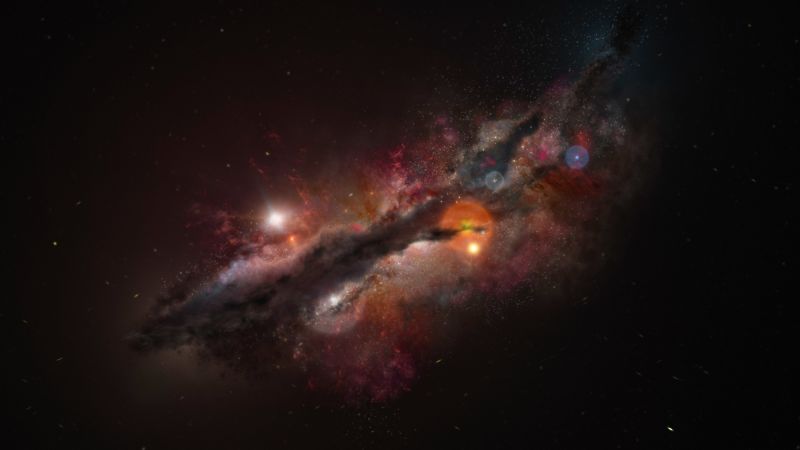Astronomers have recently made a groundbreaking discovery regarding the early universe, revealing the presence of oxygen and heavy metals in the farthest known galaxy, named JADES-GS-z14-0. This remarkable galaxy, situated an astonishing 13.4 billion light-years away, provides crucial insights into the universe’s formative years, particularly its development shortly after the Big Bang, which is believed to have occurred approximately 13.8 billion years ago.
The James Webb Space Telescope (JWST) was pivotal for this discovery, initially detecting JADES-GS-z14-0 in January 2024. JWST utilizes infrared technology to observe cosmic phenomena that are invisible to the human eye. This capability allows astronomers to look back in time, catching a glimpse into the early epoch of Cosmic Dawn, which spans the first few hundred million years of the universe’s development and the formation of its initial galaxies.
Light emitted from JADES-GS-z14-0 has traveled 13.4 billion years to reach Earth, which means that astronomers are observing the galaxy as it existed when the overall universe was a mere 300 million years old. Follow-up observations made with ALMA (the Atacama Large Millimeter/submillimeter Array located in the Atacama Desert of Chile) confirmed the initial findings from JWST. The presence of oxygen and heavy metals in JADES-GS-z14-0 has sent shockwaves through the astronomical community because their existence implies galaxies formed much more rapidly than was previously anticipated during the universe’s infancy.
The research findings, which are published in separate studies in The Astrophysical Journal and Astronomy & Astrophysics, underscore this rapid formation and maturation of early galaxies. Sander Schouws, the lead author of one of the studies and a doctoral candidate at Leiden Observatory, highlighted this phenomenon by stating, “It is like finding an adolescent where you would only expect babies.” Such assessments add to an ever-growing body of evidence suggesting that the formation of galaxies transpired at a hastened pace than once believed.
The remarkable characteristics of JADES-GS-z14-0, especially its significant mass and brightness, were contrary to the expectations of astronomers. While surveying over 700 distant galaxies, JWST identified this galaxy as the third brightest, despite it being the most distant. Typically, the earliest galaxies in the universe are believed to be smaller and dimmer due to the compressed scale of the universe at that time.
Schouws further elaborated on the uniqueness of such early galaxies, indicating that they differ enormously from well-known galaxies showcased in stunning Hubble or JWST images. Early galaxies like JADES-GS-z14-0 are more compact, rich in gas, and display a significant level of chaos as rapid star formation occurs within a relatively small region.
The prevailing understanding of galaxy formation involves massive clouds of gas that collapse and rotate, giving birth to young stars primarily composed of lighter elements such as helium and hydrogen. Over time, these stars evolve and produce heavier elements through nuclear fusion, which, upon their demise, are dispersed throughout the galaxy. This process, in turn, facilitates the formation of additional stars and planetary systems. However, the case of JADES-GS-z14-0 challenges this narrative, as it contains tenfold more heavy elements than anticipated.
Dr. Stefano Carniani, an assistant professor at Scuola Normale Superiore in Pisa, Italy, and lead author of another key study, stated that the quantity of oxygen present in JADES-GS-z14-0 indicates that several generations of massive stars must have already existed and met their stellar fates, thus triggering the rapid evolution of galaxy formation much sooner than previously theorized.
The combination of JWST and ALMA offers a dual approach to explore cosmic history, permitting astronomers to examine these early galaxies’ formation and evolution with greater precision. Rychard Bouwens, an associate professor at Leiden University, reflected on their coordinated efforts, affirming that future observations might further illuminate the enigmatic conditions present during Cosmic Dawn, which remain shrouded in mystery.
As researchers digest these revelations, Gergö Popping from the European Southern Observatory expressed excitement over the clear detection of oxygen, remarking that it signifies galaxies may indeed form much quicker post-Big Bang than previously understood. The interplay between JWST’s broad observational capabilities and ALMA’s detailed study of gas and dust in these galaxies is crucial for unraveling the mysteries of the universe’s initial stages.
Overall, while these findings paint an exciting picture of the early universe, they also raise questions about whether JADES-GS-z14-0 is an anomaly or part of a larger population of rapidly forming, heavy-element rich galaxies that may exist in the deep cosmos. Continued research is imperative to ascertain whether this unique galaxy is a solitary example or indicative of broader patterns in galaxy formation during the universe’s infancy.












